FERRYVILLE - Ferryville Eagle Days was another smashing success last weekend. Representatives of U.S. Fish & Wildlife Services, The Raptor Center – University of Minnesota, and the Raptor Resources Center in Decorah, Iowa, were on-hand to educate the crowd and show live birds. The kids enjoyed crafts and Eagle-themed treats, and of course, the Hooting Contest.
The event was sponsored by the Ferryville Tourism Council, and the Friends of Pool 9. The mission of Friends of Pool 9 is to conserve the cultural and natural resources within Pool 9 of the Upper Mississippi River National Wildlife and Fish Refuge, and to foster wise public use and enjoyment of the Refuge and the River.
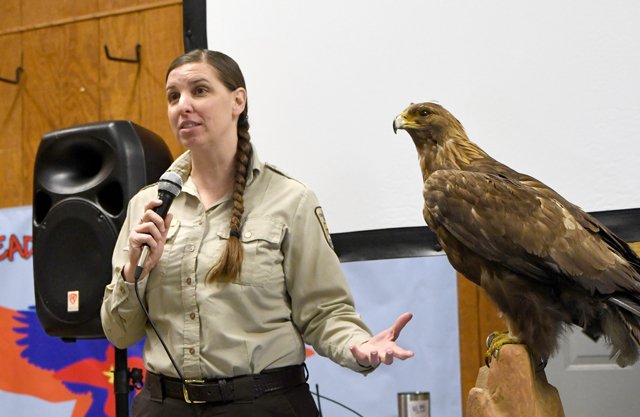

Fish & Wildlife Service
First up was Erica Rasmussen, Environmental Education Specialist with the U.S. Fish & Wildlife Service. Ramussen is based at the Genoa National Fish Hatchery, and oversees education efforts for the Hatchery and at the Great River Road Interpretive Center.
“We have 201 active eagle nests in Pool 9 of the Mississippi River between Genoa and Lynxville,” Rasmussen shared enthusiastically. “That means there are 402 eagles, and each pair will hatch out clutches of 1-3 eggs. It’s really miraculous to see how the eagles have recovered from the negative impacts of the DDT pesticide.”
Rasmussen brought two stuffed eagles with her for her presentation – a Golden Eagle and a juvenile Bald Eagle. She said that you can tell the two species apart by the fact that the feathers on Golden Eagles legs go all the way to their feet, whereas the feathers of bald eagles end well above their feet. She said that this is because the diet of Bald Eagles is primarily fish, whereas Golden Eagles will hunt for land mammals.
“Juvenile bald eagles at first glance may look a lot like Golden Eagles,” Rasmussen said. “Bald Eagles don’t fully develop their while spots on their heads and tails until they are about five years old.”
Golden Eagles, Rasmussen said, may be seen more often in this area in the winter as they migrate in search of food, and probably represent about five percent of the total eagle population in winter. She said, though, that the eagles are primarily found in Alaska and Canada. She said that Golden Eagles are more territorial in their pairs, whereas Bald Eagles are more sociable and can often be found in clusters.
The eggs of both species of eagles, according to Rasmussen also have a different appearance. Bald Eagle eggs are a dull white color with no other marking, and the eggs of Golden Eagles are a cream-to-pink color with brown blotches.
“Bald Eagles will return to the same nest year after year, with one pair that we’ve watched using the same nest for 30-34 years,” Rasmussen said. “A Bald Eagle will live in the wild for about 30 years, and a Golden Eagle will live for about 35 years.”
Rasmussen then invited all the children in the room to come forward to help in building an eagle’s nest using sticks and grasses.
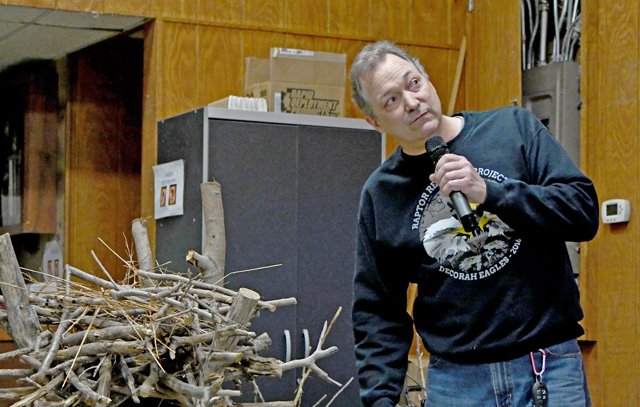

Raptor Resource Project
John Howe, Executive Director of the Raptor Center in Decorah, Iowa, was able to broadcast the livestream of the eagle nests monitored by his organization for Eagle Days participants. The audience seemed mesmerized by the video of the live birds, sitting on their eggs, building their nests, and just generally living in the wild.
Howe explained that Bob Anderson founded the Raptor Resource Project in 1988 to breed and release peregrine falcons as part of a nationwide effort to return the highly endangered species. Since its initial founding, the project has become involved in managing peregrine falcons and other birds of prey, installing camera systems, and providing an online education to viewers. You can find links to the livestream of the group’s various live cams at www.raptorresource.org on the ‘watch birds’ tab.
Live birds
As always, the highlight of the Eagle Days event is the showing of various live birds. The birds who serve as education partners with the staff at The Raptor Center are for one reason or another unfit to continue to live in the wild. Reasons vary from injuries, illnesses and human imprinting.
Anna Voss, a Naturalist with The Raptor Center, brought four birds with her to captivate the crowd. Those birds were a Red Tailed Hawk, a Kestrel, a Great Horned Owl and a Bald Eagle.
“Our center is located in St. Paul, Minn., and we act as a hospital for raptors,” Voss explained. “Each year we see as many as 1,000 birds that come to us from locations across the nation, and we have 300 volunteers that help us secure the birds and get them to our facility.”
Voss said that the Center typically houses about 30 total birds on a permanent basis that can no longer live in the wild.
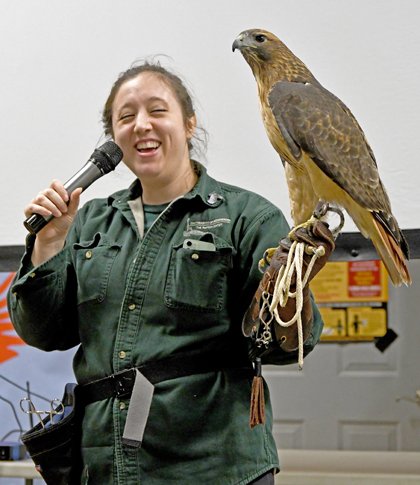

The first bird shown by Voss was a female Red Tailed Hawk named Alulah. She explained that hawks, like other raptors, are meat eaters, and they all have big eyes to look for their prey and talons to catch their food – if they use their beak to catch their food, then they’re not a raptor.
“A Red Tailed Hawk can swallow a whole mouse,” Voss said. “But if their prey is bigger than that, then they will typically stand on it and use their beak to tear pieces off – like a fork and knife.”
Voss said that Alulah could no longer live in the wild because she is blind in one eye after being infected with West Nile Virus, which did permanent damage to one of her eyes. She said that the bird weighs about three pounds, with hollow bones, and that about half of her size is in her feathers. She said that a Red Tail Hawk will develop their red tail feathers at about two years of age, and before that have black and brown stripes on their tail feathers.
Voss said that Alulah is currently 16 years old, and in the wild, would live to be about 20 years old. She said that in captivity, she would likely live for about 30 years.
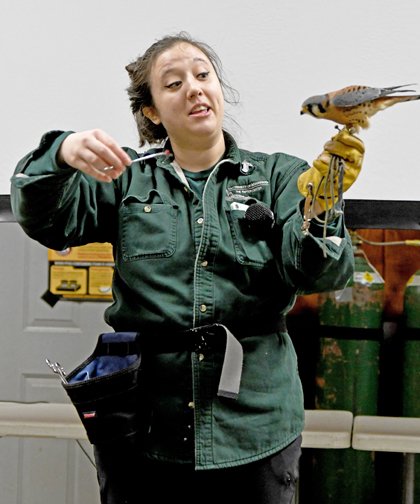

The second bird Voss showed was a three-year-old American Kestrel named Cricket. Voss told the group that Kestrels are the smallest raptors, and typically eat other birds which they catch in the air. She said they are migratory, and return to this area in the spring when they nest in holes in trees.
Cricket is a male Kestrel, and so is more brightly colored than the female of the species. Females are more brown and tan versus the brighter red and brown colors of the males. Two of their signature behaviors are head bobbing and tail tapping. Their long tails help them to be more aerodynamic, and the dark stripes under their eyes help them to see with the sun in their eyes while hunting.
Voss said that Cricket is at their Center because he was a human imprint, which prevented him from learning to live as a Kestrel in the wild. This happened after he fell out his nest when he was a baby.
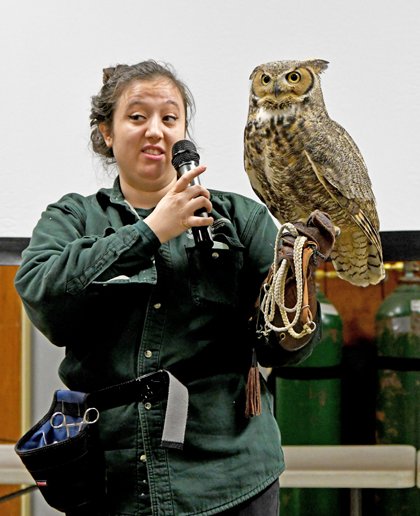

Lois the Great Horned Owl has been a repeat attendee at Ferryville Eagle Days, and an experienced performer. Lois is at the Center because she too was a human imprint, and never learned to live in the wild as an owl.
“Owls are the slowest, but the stealthiest of the raptors,” Voss explained. “Their feathers give them camouflage in trees, and their soft feathers with serrated edges allow them to fly silently.”
Voss said that owls are typically most active near sunrise and sunset, and they have huge eyes that take up most of their skull, and have the ability to turn their heads almost 360 degrees. She said that they hunt as much by hearing as by sight, and their flat faces serve to funnel sound to their ears. Voss said an owl can hear a mouse under a foot of snow.
“Owls are the first raptors to nest in the year, laying their eggs in January and February,” Voss explained. “They live in our area year round, and because they’re such fierce predators, at times you will see other birds join together to try to drive an owl out of an area.”
The typical prey of an owl includes mice, squirrels, skunks and other rodents of that size. Voss said that owls prefer food that they can fly away with because eating on the ground can expose them to other predators, and this limits the size of the prey that the owl prefers.
Of course, the last bird up was the star of the show – it WAS Eagle Days after all. Pi is a 14-year-old male Bald Eagle that lives at the center because he was “excessively socialized” by humans, and came to prefer food he could get from humans over hunting for his own food. Voss told some humorous stories of incidents that led to Pi being brought to the Center, such as ripping apart cushions on boats and other nuisance behaviors.
“Pi weighs about nine pounds, so the biggest fish he could catch and carry would be about half of his body weight,” Voss said. “But Eagles aren’t picky, and will sometimes eat something that is already dead or steal food from another bird.”
Voss said that Eagles can fly as fast as 60-miles-per-hour, are scavengers who will take free food if it is available, and have been off the list of endangered species since 2007.





